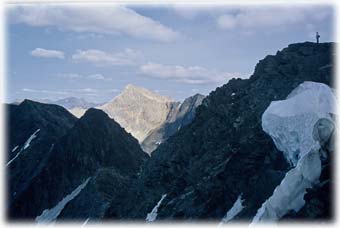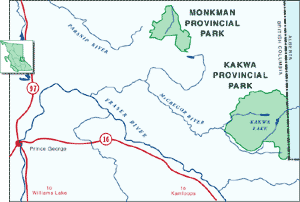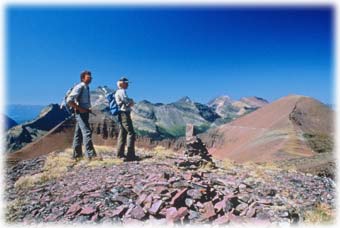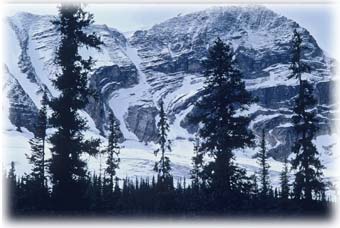|
|
 |
|
|
 A combination of towering ice capped peaks and glittering lakes of extraordinary colours makes Kakwa Provincial Park in BC's north central Rocky Mountains a stunning area to visit. Remote and wild, the 170,890 ha (422,286 acre) park, with its abundant recreational, wildlife viewing, and photographic opportunities, is a paradise to backcountry enthusiasts. Located on the continental divide, this park contains striking sedimentary mountains, such as pyramid shaped Mt. Ida, numerous lakes of various sizes, and alpine meadows resplendent with wildflowers. Kakwa's impressive mountains include the most northerly peaks over 10,000 feet (3,048 meters) found in the Canadian Rockies. The combination of icy peaks rising from vast forests makes Kakwa a dramatic place to visit and explore. A combination of towering ice capped peaks and glittering lakes of extraordinary colours makes Kakwa Provincial Park in BC's north central Rocky Mountains a stunning area to visit. Remote and wild, the 170,890 ha (422,286 acre) park, with its abundant recreational, wildlife viewing, and photographic opportunities, is a paradise to backcountry enthusiasts. Located on the continental divide, this park contains striking sedimentary mountains, such as pyramid shaped Mt. Ida, numerous lakes of various sizes, and alpine meadows resplendent with wildflowers. Kakwa's impressive mountains include the most northerly peaks over 10,000 feet (3,048 meters) found in the Canadian Rockies. The combination of icy peaks rising from vast forests makes Kakwa a dramatic place to visit and explore.
"Located on the continental divide, this park contains striking sedimentary mountains, including pyramid shaped Mt. Ida, numerous lakes of various sizes, and alpine meadows resplendent with wildflowers."
|

This park is located on the BC/Alberta Border, 180 km (113 mi) east of Williams Lake or 70 km (44 mi) north of McBride. It is a remote park with challenging road access; there is a rough dirt track road which, depending on weather and road conditions, is accessible from Highway 16. (Check for current road conditions before venturing into this park.) A gravel access route from near Highway 16 is available primarily for horses and snowmobiles. Horses can also enter the park through Dead Horse Meadows in Alberta (from Grand Prairie). Alternatively it is possible to access the park by chartered flight. There is some suggestion that a future road access could be established from either or both the east and west.

Click on the map to view an enlargement
|

 This is a remote park with limited developed facilities, and visitors are asked to remember to practice no trace camping, including packing out all garbage. In the summer the main activities include camping, fishing, horseback riding, and hiking. Trails are not maintained nor marked, so only those experienced in the outdoors and able to be completely self-sufficient should plan a trip into this wilderness area. One designated camping area on the shores of Kakwa Lake, which provides pit toilets and fire rings. Cabins at the south end of the lake are used in the summer as Park Headquarters, and are lived in by Park Rangers and Volunteer Hosts on duty from early spring until snow. This is a remote park with limited developed facilities, and visitors are asked to remember to practice no trace camping, including packing out all garbage. In the summer the main activities include camping, fishing, horseback riding, and hiking. Trails are not maintained nor marked, so only those experienced in the outdoors and able to be completely self-sufficient should plan a trip into this wilderness area. One designated camping area on the shores of Kakwa Lake, which provides pit toilets and fire rings. Cabins at the south end of the lake are used in the summer as Park Headquarters, and are lived in by Park Rangers and Volunteer Hosts on duty from early spring until snow.
During the winter snowmobiling and wilderness ski tours are possible activities. It should be noted that during the winter there are limited access routes. Please contact BC Parks in Prince George for information. The cabins at the south end of Kakwa Lake are available for public use during the winter, but are also used by Park Rangers, who do periodic patrols year round. While on patrol they require the use of the headquarters cabin, so those choosing to stay there should also plan to have alternative accommodation.
Interesting areas to explore in the area include Kakwa, and Jarvis Lakes, as well as several smaller alpine lakes. Kakwa, Cecelia and Babette lakes were stocked with Rainbow Trout at one point, but BC Parks requests that fishers only take a few fish since there are no studies available on fish populations. Please remember that all fishers must have a valid fishing licence. Other areas of interest include Mt. Sir Alexander, Mt. Ida and some fossil and cave formations.
"Interesting areas to explore in the area include Kakwa, and Jarvis Lakes, as well as several smaller alpine lakes."
|

 Kakwa Park, with its folded and layered sedimentary mountains, lakes, and alpine wildflower meadows, is home to a wide variety of species. Black and grizzly bears, wolves, wolverines, Mountain goats, caribou, moose, elk and marten are common within the park. Kakwa also contains one of the most northerly Rocky Mountain bighorn sheep populations. Kakwa Park, with its folded and layered sedimentary mountains, lakes, and alpine wildflower meadows, is home to a wide variety of species. Black and grizzly bears, wolves, wolverines, Mountain goats, caribou, moose, elk and marten are common within the park. Kakwa also contains one of the most northerly Rocky Mountain bighorn sheep populations.
There are several biogeoclimatic zones in the park including Spruce-Willow-Birch, Englemann Spruce-Subalpine Fir, and Alpine Tundra at higher locations. Ecologically, Kakwa is distinctive since it is the only park in the BC Parks system that preserves examples of the North Continental Ranges Landscape.
"Kakwa Park, with its ice-capped mountain, shimmering lakes, and extensive alpine wildflower meadows, is home to a wide variety of species."
|

The Kakwa area was first identified as having park potential by one of BC's first conservationists, Ken Farquharson. At the time Farquharson, who had previously headed up efforts to safeguard Skagit Valley and Cypress Bowl, was working as an environmental consultant looking at the prospects of proposed coal development in northeast British Columbia. In the late 1970s, while flying back from the proposed Tumbler Ridge coal field, Farquharson flew over Kakwa in a helicopter and became intrigued by the exceptional scenery he encountered. It was his vision that first alerted Parks Branch to the area's preservation potential.
Subsequently, Parks Branch pursued protection for the area and on March 14, 1987 Kakwa became a Recreation Area. It did not achieve full park status at that time because the BC government, in order to retain the option of a possible quartzite quarrying opportunity, was unwilling to dedicate it a full Class A Park.
Kakwa finally achieved full Class A Park status in June 1999, when the Prince George Land and Resource Management Plan was negotiated. The land use process not only confirmed it as a provincial Class A Park but also expanded it to the north to include the Narraway drainage, because by then conservationists had realised was missing from the initial boundaries.
"In the late 1970s, while flying back from the Tumbler Ridge proposed coalfield, Farquharson flew over Kakwa in a helicopter and became intrigued by the exceptional scenery he encountered."
Return to the Northern Rockies Region
Become Involved!

|
|

